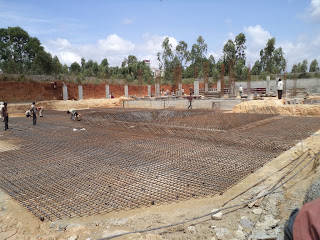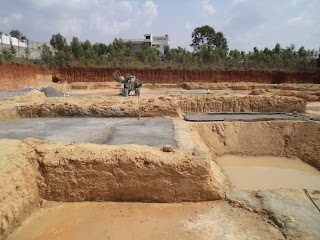BHUVANA GREENS
My home. My paradise.
Saturday, July 30, 2011
Thursday, July 21, 2011
Sunday, June 12, 2011
Site Work Progress 10.6.11
 |
| Concrete Batching Plant |
 |
| Earth Works in progress |
 |
| Part of T2 works |
 |
| Reinforcement works at site |
 |
| T1 raft reinforcement works in progress |
 |
| T2 lift pit works |
 |
| T2 Main raft part and back side retaining wall |
 |
| View from Tower 2 NE corner |
 |
| View from T2 North |
 |
| View of completed portion of T1 raft and a few columns |
 |
| View of site from batching plant - concrete pipe can be seen |
Saturday, June 4, 2011
Reduce ecological impact of corporate meetings and events
14 ways to reduce the ecological impact of corporate events and meetings—some simple and cheap, some not so much.
1. Use LEDs
Lighting is one of the most obvious ways an event consumes energy, and a growing number of technologies offer more earth-friendly solutions. While long-life fluorescent bulbs are replacing traditional incandescent lights in consumers' homes, this isn't a practical solution for most event planners.
LED lights, on the other hand, win raves from lighting and event specialists for their convenience and low energy usage. An LED fixture of comparable brightness uses up to 80 percent less energy than its conventional counterpart. Another perk of LED lights is that the lights themselves come in every color of the rainbow, so there's no need to set up huge (and labor-intensive) rigs with films if you want a multicolored look.
2. Rethink Your Cars
While hybrid cars such as the Toyota Prius are the best-known, there are a variety of alternative-fuel vehicles on the road, and a few forward-thinking car services are offering these vehicles. For large groups, the company can offer hybrid diesel shuttles as an alternative.
3. Table New Cloths
Now let's look at table linens—and the materials they're made of. As with food, you can go the organic route, using organic cotton and linen. While hemp has an earth-friendly image, environmental experts are on the fence as to its actual benefits as an eco-friendly event textile; proponents point out that it's much easier on the earth to grow hemp than to grow cotton or to produce synthetics like polyester. And don't forget to ask about the dye process—conventional dyeing methods use harsh chemicals.
Before placing an order, consider this: If you're not having linens custom-made, you'll probably be reusing existing linens, and reusing is always a green option.
4. Go Organic
It's hard to find a person who isn't acquainted with the idea of chemical- and additive-free food, and a growing number of companies are turning to sustainable and organic catering for internal as well as promotional events.
5. Skip the Styrofoam
Rental firms can rejoice—their business model is already eco-friendly. When it comes to disposables, plastic and plastic-foam dishes are so last century. The cutting edge of disposable tableware is plates, bowls, and even flatware made from plant-based materials: starches from corn, potatoes, or sugarcane, or fast-growing plants like bamboo.
6. Reduce Garbage
Many green events have prominently displayed recycling containers next to regular trashcans, and a few have gone so far as to include composting containers.
7. Avoid Vinyl
Vinyl is the conventional choice for a customized backdrop; what it offers in ubiquity and convenience, however, it lacks in earth-friendliness. Not only is the material made from nonrenewable resources, but there's no way to recycle it effectively.
That said, it's tough to find a replacement without dreaming up an entirely different kind of display, which will be pricier and more complicated.
8. Donate Leftovers
Another way to reduce an event's waste is by donating leftovers. It can be harder to track down groups that want to take your leftovers outside of major cities. You will always be able to find someone—sometimes even a homeless shelter—grateful for the provisions, but sometimes it takes more work. Ask your venue, though; the folks there can often point you in the direction of a recipient.
Cost: Since most food-rescue organizations will provide containers for packaging leftovers and pick up the food, this shouldn't put a ding in your budget at all. The exception would be if you're donating on a one-off basis to a group (such as a shelter) that doesn't have an established program; in that case, you might need to factor in the expense of containers and ferrying the food to its destination.
9. Keep Plants Alive
Depending on whether or not you plan to reuse them for future events, using plants can be a highly cost-effective option—provided the decorations and planters aren't overly extravagant.
10. Nix Single Servings
Water bottles are convenient and ubiquitous, but all those bottles usually wind up in landfills, and the water in half-full bottles is poured down the drain—a tremendous waste, environmental advocates say. Lunches should not be pre-boxed if possible, and side items like chips and cookies should be offered loose, in bowls or platters rather than in individual packages.
11. Offset Emissions
Carbon offsetting has gotten a lot of buzz lately, but environmental experts are divided on its effectiveness. It works like this: Go to the Web site of a carbon-offsetting service such as Driving Green or Carbon Fund and plug in a few vital stats about your event. The service calculates how much carbon dioxide the event will produce and gives you a dollar amount.
12. Tweak the Temp
Controlling the temperature in the room can definitely be earth-friendly—lowering the heat in the winter and keeping the AC down or off in the summer both save energy. The question remains whether it's guest-friendly as well
13. Print Wisely
Event specialists have many options when it comes to making invitations and programs more eco-conscious. When it comes to ink, soy-based inks are preferable to conventional inks, which are made from nonrenewable petroleum. But an even more earth-friendly option is using vegetable-based inks, since soybeans aren't always grown in an eco-friendly manner. Ask upfront if your printer can provide one or the other, since eco-friendly inks aren't yet as commonly available as recycled paper.
14. Cut the Handouts
For some events, the option of replacing paper programs or binders with CDs or flash drives—thumb-sized devices that store data and can be plugged into any computer's USB port—can be a godsend. If attendees typically leave laden with handouts (including many, let's face it, they'll never look at), flash drives are not only thoughtful but stand a better chance of actually being taken home and read. You can also consider having maps and directions available for download onto cell phones, PDAs, or other gadgets, so guests don't have to print them out, if you have an appropriately tech-savvy crowd.
Tuesday, May 31, 2011
Bhuvana Greens - Work in Progress
 |
| Panoramic View 28th May, 2011 |
 |
| Retainer wall in progress |
 |
| Retainer wall in progress 2 |
 |
| Tower 1 Basement columns work in progress |
 |
| Tower 2 Basement work |
 |
| Tower 1 Basement work |
TOWER 1 :
- PODIUM FLOORING AND COLUMNS CONCRETE IN PROGRESS
- MAIN FOOTINGS/ RAFT REINFORCEMENT AND CONCRETE WORKS IN PROGRESS
- RETAINING WALL WORKS IN PROGRESS
TOWER 2 :
- PODIUM FLOORING AND COLUMNS CONCRETE IN PROGRESS
- MAIN FOOTINGS/ RAFT REINFORCEMENT WORKS IN PROGRESS
Tuesday, May 17, 2011
Sunday, May 15, 2011
Waste Segregation
A kabadiwala is welcomed with much fanfare at Indian homes, with people disposing of old newspapers, books, cans etc. This is a form of segregation we have been used to see, since childhood, when on lazy Sunday mornings we would take pride in "cleaning" the trash. This was a religious routine in our homes.
But as time has moved ahead, so has the needs to refine this method. Segregation of waste is the method of separation of waste, so that accordingly the waste which is not bio-degradable can be recycled or re-used. Actually a part of the waste can be converted to compost or manure, the other can be recycled, only a very small part of it has to be discarded.
Household waste should be disposed off separately as wet and dry waste. Toxic wastes like batteries, medicines, bulbs should be disposed separately. Wet waste, which consists of leftover foodstuff, vegetable peels, etc., should be put in a compost pit and the compost could be used as manure in the garden. Dry waste consisting of cans, aluminium foils, plastics, metal, glass, and paper could be recycled. If we do not dispose of the waste in a more systematic manner, more than 1400 sq. km of land, which is the size of the city of Delhi, would be required in the country by the year 2047 to dispose of it.
But as time has moved ahead, so has the needs to refine this method. Segregation of waste is the method of separation of waste, so that accordingly the waste which is not bio-degradable can be recycled or re-used. Actually a part of the waste can be converted to compost or manure, the other can be recycled, only a very small part of it has to be discarded.
Household waste should be disposed off separately as wet and dry waste. Toxic wastes like batteries, medicines, bulbs should be disposed separately. Wet waste, which consists of leftover foodstuff, vegetable peels, etc., should be put in a compost pit and the compost could be used as manure in the garden. Dry waste consisting of cans, aluminium foils, plastics, metal, glass, and paper could be recycled. If we do not dispose of the waste in a more systematic manner, more than 1400 sq. km of land, which is the size of the city of Delhi, would be required in the country by the year 2047 to dispose of it.
Door-to-door collection of waste is another method of segregation, but it is not a common practice as yet in India except in the metros where some private organizations are doing such work. The rag picker plays a very important part in the segregation of waste.
It is now becoming more and more essential to look for methods by which the garbage load on the land can be reduced. It has been seen that at present segregation of waste at source level seems to be the best.
A large number of NGOs (non-governmental organizations) are working in the field of solid waste management such as Clean Ahmedabad Abhiyan in Ahmedabad, Waste-Wise in Bangalore, Mumbai Environmental Action Group in Mumbai, and Vatavaran and Srishti in Delhi. They are all successfully creating awareness among the citizens about their rights and responsibilities towards solid waste and the cleanliness of their city. These organizations promote environmental education and awareness in schools and involve communities in the management of solid waste.
The role of the rag picker
Rag pickers are the people who are actually going through the garbage bins to pick out the ‘rags’. These rag pickers, women, children, and men from the lowest rung in the society, are a common sight in most cities and towns around the country. Rag picking is considered the most menial of all activities and it is people who have no other alternative that are generally driven to it. Rag pickers contribute a great deal to waste management as they scavenge the recyclable matter thereby saving the municipality of the cost and time of collecting and transporting this to the dumps.
The rag picker has a special role to play in the segregation of waste in India. He is one of the focal points for the recycling of waste. He is the person who, in spite of all the dangers that he faces, goes on relentlessly picking through the garbage bin, looking for waste that could be useful to him. He sells all the material he picks to the whole sellers and retailers who in turn sell it to the industry that uses this waste matter as raw material. The main items of collection are plastics, paper, bottles, and cans.
Rag pickers are well coordinated in their method of working. Among themselves, they have a good understanding for operating by area. Each group takes specific items from the bins. It has been observed that more and more women and children are getting involved in the business of rag picking. This is a matter of concern as these children who should be spending their time in schools either studying or playing are instead putting themselves at risk by handling waste. While picking through waste, the rag picker puts himself at a great risk and is always prone to disease as the waste that he rummages through can be infected.
We can indirectly help the rag picker by carefully segregating the waste that is generated at our homes, thereby facilitating his search for materials that are useful to him. He will not have to scavenge in the bins for long hours.
Subscribe to:
Comments (Atom)













